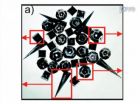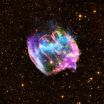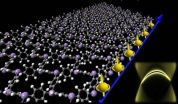(Press-News.org) Philadelphia, Pa. (February 13, 2013) – For many patients with difficult-to-treat neuropathic pain, deep brain stimulation (DBS) can lead to long-term improvement in pain scores and other outcomes, according to a study in the February issue of Neurosurgery, official journal of the Congress of Neurological Surgeons. The journal is published by Lippincott Williams & Wilkins, a part of Wolters Kluwer Health.
About two-thirds of eligible patients who undergo DBS achieve significant and lasting benefits in terms of pain, quality of life, and overall health, according to the report by Sandra G.J. Boccard, PhD, and colleagues of University of Oxford, led by Tipu Aziz FMedSci and Alex Green, MD. Some outcomes show continued improvement after the first year, according to the new report, which is one of the largest studies of DBS for neuropathic pain performed to date.
Most Patients Benefit from DBS for Neuropathic Pain
The authors reviewed their 12-year experience with DBS for neuropathic pain. Neuropathic pain is a common and difficult-to-treat type of pain caused by nerve damage, seen in patients with trauma, diabetes, and other conditions. Phantom limb pain after amputation is an example of neuropathic pain.
In DBS, a small electrode is surgically placed in a precise location in the brain. A mild electrical current is delivered to stimulate that area of the brain, with the goal of interrupting abnormal activity. Deep brain stimulation has become a standard and effective treatment for movement disorders such as Parkinson's disease. Although DBS has also been used to treat various types of chronic pain, its role in patients with neuropathic pain remains unclear.
Between 1999 and 2011, that authors' program evaluated 197 patients with chronic neuropathic pain for eligibility for DBS. Of these, 85 patients proceeded to DBS treatment. The remaining patients did not receive DBS—most commonly because they were unable to secure funding from the U.K. National Health Service or decided not to undergo electrode placement surgery.
The patients who underwent DBS were 60 men and 25 women, average age 52 years. Stroke was the most common cause of neuropathic pain, followed by head and face pain, spinal disease, amputation, and injury to nerves from the upper spinal cord (brachial plexus).
In 74 patients, a trial of DBS produced sufficient pain relief to proceed with implantation of an electrical pulse generator. Of 59 patients with sufficient follow-up data, 39 had significant improvement in their overall health status up to four years later. Thus, 66 percent of patients "gained benefit and efficacy" by undergoing DBS.
Benefits Vary by Cause; Some Outcomes Improve with Time
The benefits of DBS varied for patients with different causes of neuropathic pain. Treatment was beneficial for 89 percent for patients with amputation and 70 percent of those with stroke, compared to 50 percent of those with brachial plexus injury.
On average, scores on a 10-point pain scale (with 10 indicating the most severe pain) decreased from about 8 to 4 within the first three months, remaining about the same with longer follow-up. Continued follow-up in a small number of patients suggested further improvement in other outcomes, including quality-of-life scores.
Deep brain stimulation has long been regarded as potentially useful for patients with severe neuropathic pain that is not relieved by other treatments. However, because of the difficulties of performing studies of this highly specialized treatment, there has been relatively little research to confirm its benefits; only about 1,500 patients have been treated worldwide. The new study—accounting for about five percent of all reported patients—used up-to-date DBS technologies, imaging, and surgical techniques.
Dr. Boccard and coauthors acknowledge some important limitations of their study—especially the lack of complete patient follow-up. However, they believe their experience is sufficiently encouraging to warrant additional studies, especially with continued advances in stimulation approaches and technology. The researchers conclude, "Clinical trials retaining patients in long-term follow-up are desirable to confirm findings from prospectively assessed case series."
###
About Neurosurgery
Neurosurgery, the Official Journal of the Congress of Neurological Surgeons, is your most complete window to the contemporary field of neurosurgery. Members of the Congress and non-member subscribers receive 3,000 pages per year packed with the very latest science, technology, and medicine, not to mention full-text online access to the world's most complete, up-to-the-minute neurosurgery resource. For professionals aware of the rapid pace of developments in the field, Neurosurgery is nothing short of indispensable.
About Lippincott Williams & Wilkins
Lippincott Williams & Wilkins (LWW) is a leading international publisher of trusted content delivered in innovative ways to practitioners, professionals and students to learn new skills, stay current on their practice, and make important decisions to improve patient care and clinical outcomes. LWW is part of Wolters Kluwer Health, a leading global provider of information, business intelligence and point-of-care solutions for the healthcare industry. Wolters Kluwer Health is part of Wolters Kluwer, a market-leading global information services company with 2011 annual revenues of €3.4 billion ($4.7 billion).
For some, deep brain stimulation brings lasting improvement in neuropathic pain
Large study shows continued improvement with longer follow-up, reports Neurosurgery
2013-02-13
ELSE PRESS RELEASES FROM THIS DATE:
Busy beavers give Canada geese a lift, study shows
2013-02-13
A new University of Alberta study shows that busy beavers are helping Canada geese get an earlier start when the birds fly home and begin spring nesting.
Ponds in Alberta where beavers were active tended to result in earlier thaw of winter snowpack, giving the geese a better chance at reproductive success, according to the study, published recently in Mammalian Biology.
The study is the first to link beavers to early season nesting habits of Canada geese in a Northern climate.
A team led by Glynnis Hood, an associate professor in the Department of Science at the ...
'Masked' mold toxins in food should be included in safety regulations
2013-02-13
Government limits on mold toxins present naturally in grain crops should be expanded to include so-called "masked mycotoxins" that change from harmless to potentially harmful forms in the body, a new study concludes. It appears in ACS' journal Chemical Research in Toxicology.
Chiara Dall'Asta and colleagues explain that molds growing naturally on wheat, corn and other plants produce toxic substances termed mycotoxins. Some health experts regard mycotoxins as the most serious chronic dietary risk factor, greater than the potential health threats from pesticides and insecticides. ...
Origami meets chemistry in scholarly video-article
2013-02-13
February 13, 2013
Cambridge, MA: The nanotechnology research space is rapidly growing, with vast implications for the healthcare, consumer electronics, surveillance, and defense industries. However, a major limitation to this research is the ability to create particles that vary in shape and function on a micrometer or nanometer scale.
To overcome these limitations, chemical engineers at Johns Hopkins University have developed self-assembling particles that are inspired by origami, the traditional Japanese art of folding paper into complex three-dimensional shapes. ...
A cooler way to protect silicon surfaces
2013-02-13
CAMBRIDGE, MA -- Silicon, the material of high-tech devices from computer chips to solar cells, requires a surface coating before use in these applications. The coating "passivates" the material, tying up loose atomic bonds to prevent oxidation that would ruin its electrical properties. But this passivation process consumes a lot of heat and energy, making it costly and limiting the kinds of materials that can be added to the devices.
Now a team of MIT researchers has found a way to passivate silicon at room temperature, which could be a significant boon to solar-cell ...
Protein central to cancer stem cell formation provides new potential target
2013-02-13
HOUSTON - Researchers have identified a pivotal protein in a cellular transformation that makes a cancer cell more resistant to treatment and more capable of growing and spreading, making it an inviting new target for drug development.
Additionally, the international team led by scientists at The University of Texas MD Anderson Cancer Center found the cancer drug sunitinib potentially has a new role in treating triple-negative, claudin-low breast cancer, a particularly resistant version of a type of cancer that is already difficult to treat.
"We found that FOXC2 lies ...
NASA's Chandra suggests rare explosion created our galaxy's youngest black hole
2013-02-13
New data from NASA's Chandra X-ray Observatory suggest a highly distorted supernova remnant may contain the most recent black hole formed in the Milky Way galaxy. The remnant appears to be the product of a rare explosion in which matter is ejected at high speeds along the poles of a rotating star.
The remnant, called W49B, is about a thousand years old as seen from Earth and located about 26,000 light-years away.
"W49B is the first of its kind to be discovered in the galaxy," said Laura Lopez, who led the study at the Massachusetts Institute of Technology. "It appears ...
By guessing, clinicians may miss 3/4 of alcohol problems
2013-02-13
SAN ANTONIO, Texas (Feb. 13, 2013) — By relying on hunches rather than posing a few screening questions, primary care clinicians may be missing three-fourths of the alcohol problems in their patients, a newly released analysis shows.
"It's often off the radar — people come in for hypertension and are not asked how much they drink," said study co-author Barbara J. Turner, M.D., M.S.Ed., M.A., M.A.C.P., of UT Medicine San Antonio. Primary care offices typically don't have good systems to administer questionnaires to screen for certain problems, including alcohol consumption, ...
Tube versus IV feeding in malnourished pediatric cancer patients
2013-02-13
About 60 percent of pediatric cancer patients experience malnourishment during treatment. At that point, patients and families have a choice: tube feeding or IV nutrition supplement. Which would you choose? A study published this week in the Journal of Pediatric Oncology Nursing shows that families' perceptions, especially of the discomfort of tube feeding, leads to choosing IV over tube – despite the fact that tube feeding is usually the better choice, associated with better gut function and lower rates of infection.
"Despite the benefits of tube feeding, we found a ...
Key molecule suppresses growth of cancerous liver tumors, Mayo study finds
2013-02-13
ROCHESTER, Minn. -- A molecule already implicated in a number of diverse cellular functions can suppress the growth of tumors in the liver, a Mayo Clinic Cancer Center study has found. Its name is IQGAP1, and when the molecule is active in the cells that surround a tumor cell, this "tumor microenvironment" becomes less hospitable to cancer growth. When the molecule is deficient, cancer thrives.
Results of the study appear in the Journal of Clinical Investigation. The findings give new insight into cancer metastasis, the ability of a tumor to spread from its primary site ...
Engineers show feasibility of superfast materials
2013-02-13
SALT LAKE CITY, Feb. 13, 2013 – University of Utah engineers demonstrated it is feasible to build the first organic materials that conduct electricity on their edges, but act as an insulator inside. These materials, called organic topological insulators, could shuttle information at the speed of light in quantum computers and other high-speed electronic devices.
The study published this week in the journal Nature Communications will help pioneer a new field of research in materials science, in the same way organic materials lowered the cost and eased production of light-emitting ...
LAST 30 PRESS RELEASES:
Structure of dopamine-releasing neurons relates to the type of circuits they form for smell-processing
Reducing social isolation protects the brain in later life
Keeping the heart healthy increases longevity even after cancer
Young adults commonly mix cannabis with nicotine and tobacco
Comprehensive review illuminates tau protein's dual nature in brain health, disease, and emerging psychiatric connections
Book prepares K-12 leaders for the next public health crisis
Storms in the Southern Ocean mitigates global warming
Seals on the move: Research reveals key data for offshore development and international ecology
Sports injuries sustained during your period might be more severe
World's first successful 2 Tbit/s free-space optical communication using small optical terminals mountable on satellites and HAPS
Can intimate relationships affect your heart? New study says ‘yes’
Scalable and healable gradient textiles for multi‑scenario radiative cooling via bicomponent blow spinning
Research shows informed traders never let a good climate crisis go to waste
Intelligent XGBoost framework enhances asphalt pavement skid resistance assessment
Dual-function biomaterials for postoperative osteosarcoma: Tumor suppression and bone regeneration
New framework reveals where transport emissions concentrate in Singapore
NTP-enhanced lattice oxygen activation in Ce-Co catalysts for low-temperature soot combustion
Synergistic interface engineering in Cu-Zn-Ce catalysts for efficient CO2 hydrogenation to methanol
COVID-19 leaves a lasting mark on the human brain
Scientists use ultrasound to soften and treat cancer tumors without damaging healthy tissue
Community swimming program for Black youth boosts skills, sense of belonging, study finds
Specific depressive symptoms in midlife linked to increased dementia risk
An ‘illuminating’ design sheds light on cholesterol
Who is more likely to get long COVID?
Study showcases resilience and rapid growth of “living rocks”
Naval Research Lab diver earns Office of Naval Research 2025 Sailor of the Year
New Mayo-led study establishes practical definition for rapidly progressive dementia
Fossil fuel industry’s “climate false solutions” reinforce its power and aggravate environmental injustice
Researchers reveal bias in a widely used measure of algorithm performance
Alcohol causes cancer. A study from IOCB Prague confirms damage to DNA and shows how cells defend against it
[Press-News.org] For some, deep brain stimulation brings lasting improvement in neuropathic painLarge study shows continued improvement with longer follow-up, reports Neurosurgery



